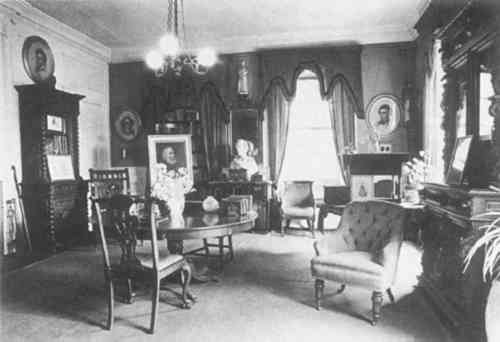THE IN SITU TREATMENT OF THE WALLPAPER IN THE STUDY OF THE LONGFELLOW NATIONAL HISTORIC SITEThomas K. McClintock
1 INTRODUCTIONHENRY WADSWORTH LONGFELLOW (1807–1882) lived in the house on Brattle Street in Cambridge, Massachusetts, from 1837 until the end of his life. Built in 1759, the house remained in the Longfellow family until 1973, when it became a National Historic Site under the direction of the National Park Service. As part of a continuing project, the house and its contents were undergoing conservation treatments. In the study, which continued to be furnished as in Longfellow's time (Fig. 1) the furniture, curtains, decorative objects and books had already been cared for. It was planned to replace the carpet with a reproduction. After the interior trim was repainted, attention was given to the wallpaper. Since the wallpaper was originally painted a single color (and repainted at a later date), one alternative was simply to remove it and paint the walls to match the original color. Because of the wallpaper's archival value to the room and its good general condition, the decision was made to conserve it in situ. It was treated in the fall of 1979 by the Northeast Document Conservation Center.
The continuing conservation project instituted by the National Park Service has included earlier treatments of other rooms. The printed wallpapers of the parlor, a floral motif circa 1840, and of the dining room, a foliage design circa 1870, were treated by the students of the Winterthur/University of Delaware Program in conservation.1 The front and back hallways, originally papered in 1859 and later painted on numerous occasions with a variety of colors, were painted again in 1950 to match original samples of wallpaper found behind a bookcase. Reproduction paper was prepared for an upstairs bedroom when the original wallpaper was discovered under modern additions. These different approaches to the treatment of wallpaper in different rooms illustrate, even within a single historic site, that a variety of treatments can be developed based on historical information and the determination of condition by the curator and the conservator. |
